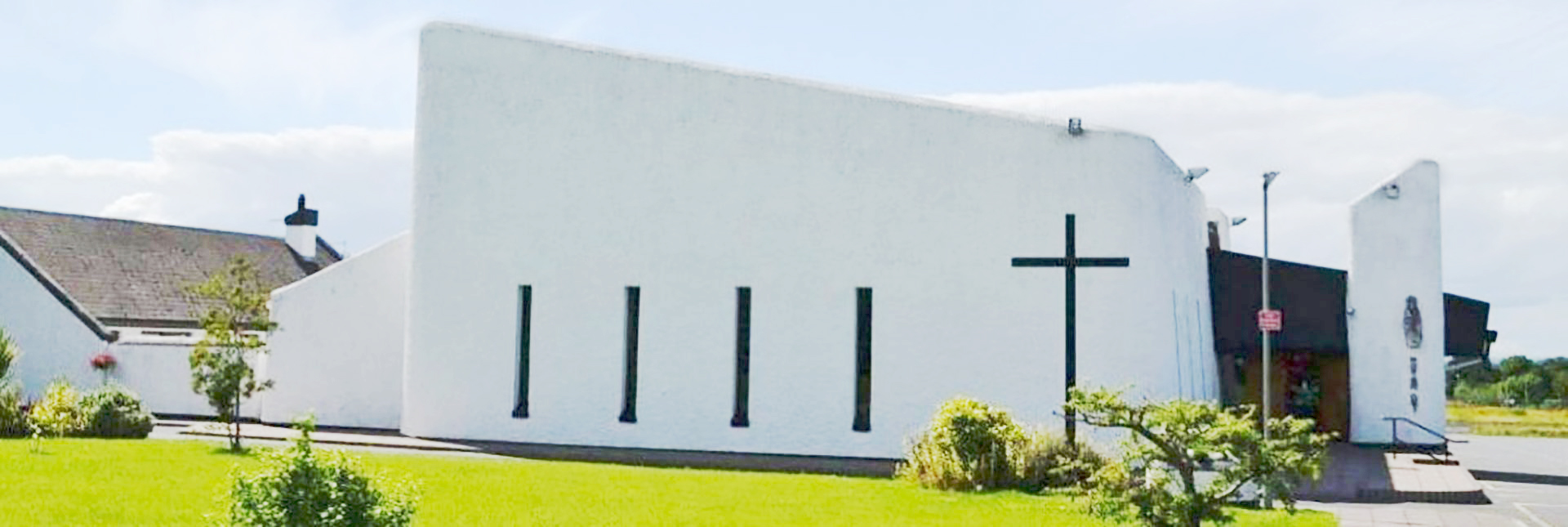
A short history of the Parish
In Christian times the earlier inhabitants of this part of County Antrim were known as the Cruithni and they claimed descent from Conall Cearnach, staunch friend of Cuchulainn and one of the noblest of the Red Branch Knights, whose king was Conor MacNessa.
St Patrick has strong associations with the Glenavy and Killead area. The name Glenavy itself is said to be derived from “Llann Abhaich”, “ the Church of the Dwarf”, ie of Daniel, the vertically challenged but saintly individual whom Patrick had left in charge of the church he founded in this area. The site of the church has been tentatively identified as being near the northern end of Glenavy village in the town land of Ballycessy close to where St Aidan’s Church of Ireland now stands, possibly on the northern side of the junction of the Pigeontown Road.
The Slige Mhidhluachra, one of the five great roads leading from Tara, ran through what is today the parish of Glenavy and Killead on its way to the sea at Dunseverick on the North Antrim Coast. Patrick may well have travelled along it after his escape from his master Milchu, or on his missionary journeys after his return to Ireland.
“The wood of Foclut”, the inhabitants of which had called Patrick back to Ireland has been identified by some scholars as being Killultagh which covers the Glenavy & Killead area.
The type of church organisation set up by St Patrick was soon displaced in Ireland by the spread of monasticism. The round tower on Ram’s Island in Lough Neagh, on the western edge of the parish, testifies to the fact that there was some kind of monastic institution there in Viking times c. 900AD. The monastery at Bangor founded by St Comgall c558 exercised jurisdiction over Glenavy for some time.
In the early flowering of Christian faith during the first millennia there is a report in the document, The Litany of Aengus, the Culdee, written in A. D. 799 stating that 7 Egyptian Coptic monks established a monastery at Dundesert east of the present day Nutts Corner roundabout. Nothing remains of the foundation, yet a stone was found near the old Camlin Church just outside Crumlin bearing Egyptian hieroglyphics. It may have marked the burial site of the seven monks. The whereabouts of this stone is unknown.
The Diocese of Connor, later to become Down and Connor, was established by the Synod of Rathbreasil, in 1111AD. Shortly after this the diocese was divided into parishes which eventually evolved into the modern parishes we know today.
St Malachy’s establishment of Camlin Church, whose ruins on the outskirts of Crumlin are still visible, was one of many acts marking this new beginning for the Church in Ireland.
The strength of faith in the Glenavy and Killead area is attested to by the number of churches which have been identified in the parish down the ages; in the town lands of Ballygortgarve, Ballykennedy, Carmavey, Killead, Ballyrobin, Camlin in Ballydonaghy Dundesert, Templecormac, Kilmackevet, Ballymacilhoyle, Ballyginniff and Glenavy.
Many of these have disappeared but some survive as ruins.
During the Penal times, 17th and 18th centuries Mass was celebrated at Chapel Hill outside Glenavy and at a Mass Rock in the town-land of the Largy in the northern end of the parish.
At the end of the 17th century Catholics in the Aldergrove area were worshipping in a ‘Mass- House’ at the end of the Diamond Road. Later they would assemble for Mass at a storehouse in Ballyginniff. In 1815 a Fr Crangle had a small chapel built at Aldergrove in the townland of Ballyquillan and it is this Church, enlarged and altered by Fr Mac Mullan sometime between 1838 and 1841 which forms the present Church of St James. The building was partly destroyed in an arson attack in 1998. It has since been refurbished in the form we know today.

In 1876 a house which stood in the grounds of St James Church opened as a school. It was replaced by a new school under the patronage of St James on the Diamond Road in April 1958 (Figure 1). This closed in 1988 with pupils and staff transferring to St Joseph’s in Crumlin.
Catholic education in Crumlin in the late 1800’s took place in a building on Lakefield Lane (Orchard Road) just off the Main street. In 1915 a Fr Francis Mc Bride was responsible for having the first dedicated Catholic School built in Crumlin (Figure 2). This served the community right up to the 1960’s when a new school dedicated to St Joseph was built a short distance away.
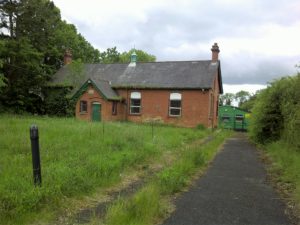
This in turn was replaced on a new site in 2005 with the present St Joseph’s to accommodate the rapidly expanding Catholic population.
In a census of 1766 the number of Catholics living in Glenavy area was given at 145 and that of Camlin (Crumlin) as 43. In the 1831 census the Catholic population of the whole area of the parish was given as 1750. Today it is about 7000.
In the 1960’s people moved to Crumlin for work at the Airport and other industries at Langford Lodge. In the 70’s there was a large influx of Catholic families escaping the troubles in Belfast. Mater Dei Church was built and dedicated in 1973 to accommodate this expanding population. It was the first Catholic Church in Crumlin of modern times. The design of the Church was influenced by a Church at Ronchamp in eastern France designed by the famous French architect Le Corbusier.
One of the demands of the Penal Laws had been that Catholics were not permitted to have their places of worship near any main roads and often had to be placed at least a mile outside any towns or villages. In 1796 the Mass house on a hill outside Glenavy village in the townland of Ballymacrickett was burned as were many others in the diocese by a group known as “the Wreckers”.
The Mass house was re-erected by Fr Crangle in the early years of the 19th Century and a modest building measuring 60 feet by 30 feet did service until the dynamic Fr Pye had the present St Joseph’s dedicated on 13 September 1868.
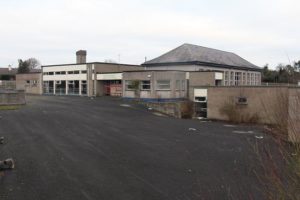
St Joseph’s was extensively altered and beautifully restored in 2008 by Fr Mc Williams with an Annex being added to the existing building.
In 1898 a National School had been established at the bottom of St Joseph’s graveyard. It was replaced in 1965 with a new Ballymacrickett Primary School on the Scroggy Road (Figure 3). This building was replaced on a new site in 2007 to accommodate the growing population. Glenavy like Crumlin has expanded rapidly in the last 30 years as people have moved from Belfast to more rural surroundings.
In the South Western part of the parish in the town land of Feumore a Catholic School was opened in 1899. A parish priest, Fr Francis Mc Bride, established the practice of celebrating Mass each Sunday in the school beginning about 1919.
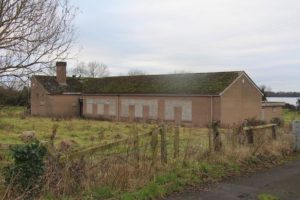
A new school dedicated to St Francis was built a short distance away in 1969 (Figure 4) which permitted the old building to be used exclusively as a Mass Centre (Figure 5) which is still in use. St Francis Primary School closed in the amalgamations of 1988 when pupils and staff transferred to Ballymacrickett P.S..
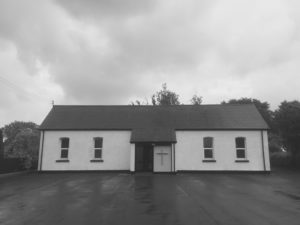
In 1960 the provision of education in the parish underwent an important change when St Aidan’s High School was blessed and opened on the Glen Road in Glenavy where Killultagh Grange housing development now stands(photo pending). Prior to the opening of St Aidan’s all post- primary education took place outside the parish. Although very successful in its time, the numbers declined as more and more children chose to attend schools in Belfast from where many of their families had moved. As a consequence of the falling rolls, St Aidan’s closed in 1992.
